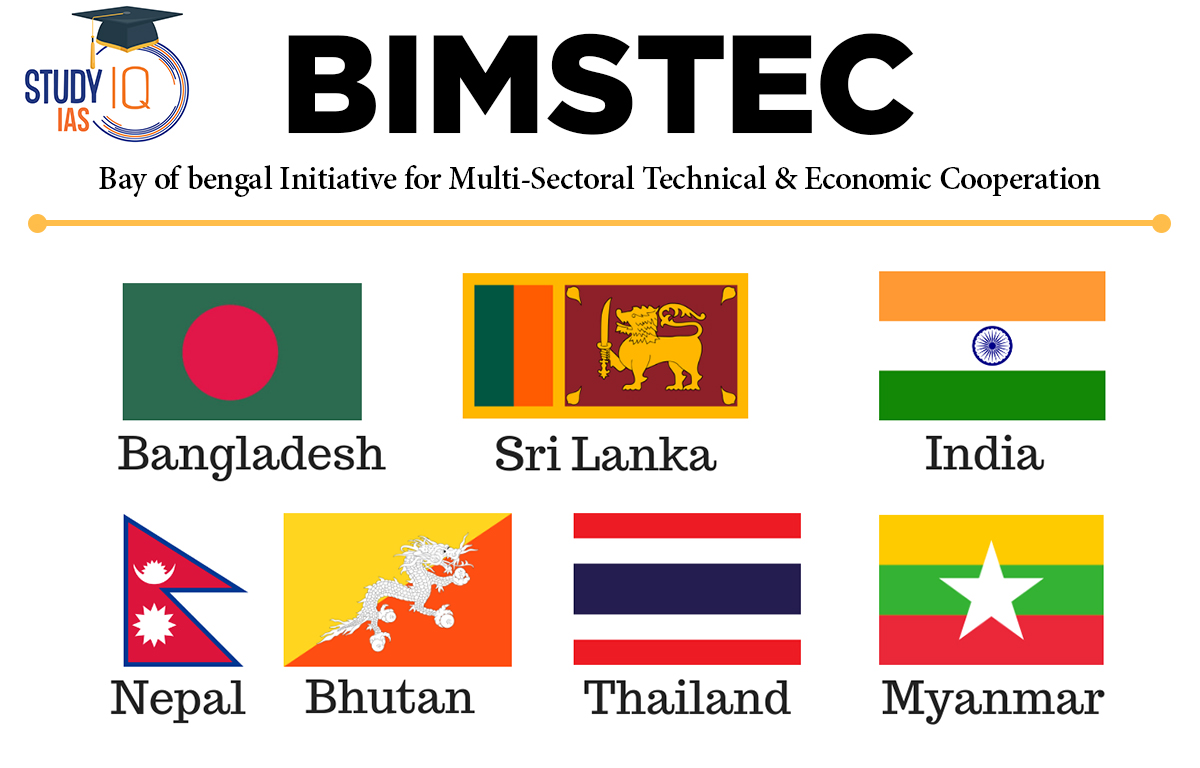Table of Contents
Context: The 6th Summit of the Heads of State/Government of the member States of BIMSTEC) was held in Bangkok, Thailand.
The Bay of Bengal Initiative for Multi-Sectoral Technical and Economic Cooperation (BIMSTEC) is an intergovernmental organization connecting South Asia and Southeast Asia through the Bay of Bengal. Established in 1997, BIMSTEC emerged as a strategic alternative to SAARC, aiming to foster regional cooperation across multiple sectors.
As of 2025, BIMSTEC Countries have assumed a renewed geopolitical and economic significance amid changing global power dynamics, particularly in the Indo-Pacific region. With increasing global polarization, BIMSTEC is becoming a vital platform for regional stability, connectivity, and development.
BIMSTEC
BIMSTEC is a multilateral regional organisation. Members of this regional unity are located along the littoral and in nearby areas of the Bay of Bengal. BIMSTEC includes not only South and Southeast Asia but also the Great Himalayan and Bay of Bengal ecologies.
| BIMSTEC Details | |
|---|---|
| Full Form | Bay of Bengal Initiative for Multi-Sectoral Technical and Economic Cooperation |
| Established | 1997 (as BIST-EC); Renamed BIMSTEC in 2004 |
| Headquarters | Dhaka, Bangladesh |
| Total Members | 7 |
| Member Countries | Bangladesh, Bhutan, India, Nepal, Myanmar, Sri Lanka, Thailand |
| Regions Covered | South Asia & Southeast Asia |
| Population (2025) | Over 1.7 billion (~22% of the global population) |
| Combined GDP (2025) | Approx. $4 trillion |
| Key Waterbody | Bay of Bengal (connects the Indian Ocean to Southeast Asia) |
| Official Language | English |
| BIMSTEC Charter Signed | March 2022 (at the 5th Summit in Sri Lanka) |
Historical Background of BIMSTEC
- 1997: Established as BIST-EC (Bangladesh, India, Sri Lanka, Thailand Economic Cooperation).
- 1998: Renamed to BIMST-EC with the inclusion of Myanmar.
- 2004: Full transformation to BIMSTEC.
- 2022: The BIMSTEC Charter was signed at the 5th Summit in Sri Lanka—transforming the group into a formal organization.
- 2025: BIMSTEC continues strengthening sectoral cooperation through assigned leadership roles to each member state.
Aim of BIMSTEC
The primary aim of BIMSTEC is to promote technical and economic cooperation among the seven member countries located around the Bay of Bengal region. It seeks to harness shared resources, boost regional integration, and promote peace, prosperity, and sustainable development across South and Southeast Asia.
| Objective | Explanation |
|---|---|
| Accelerated Economic Growth | Foster economic collaboration through trade, investment, and technology sharing to uplift the region’s socio-economic status. |
| Regional Connectivity | Improve connectivity via roads, railways, ports, and energy grids to facilitate smooth trade and people-to-people contact. |
| Multisectoral Cooperation | Enhance cooperation across 14 key sectors including trade, transport, energy, security, health, agriculture, and counterterrorism. |
| Poverty Alleviation | Promote inclusive development strategies and reduce poverty through joint initiatives and economic reforms. |
| Bridge Between South and Southeast Asia | Create a strategic regional link between SAARC and ASEAN for stronger geopolitical and economic integration. |
| Sustainable Development | Collaborate on climate change, disaster management, environmental protection, and sustainable use of marine resources. |
| Peace and Security | Combat terrorism, transnational crimes, and cyber threats through intelligence sharing and capacity building. |
| People-to-People Contact | Strengthen cultural exchanges, tourism, academic collaborations, and grassroots diplomacy to build trust and goodwill. |
BIMSTEC Countries Origin and Membership
- Founded as BIST-EC (Bangladesh, India, Sri Lanka, and Thailand Economic Cooperation) in June 1997 with the Bangkok Declaration.
- Renamed BIMST-EC with the entry of Myanmar in late 1997.
- Became BIMSTEC with the inclusion of Nepal and Bhutan in 2004.
- Bay of Bengal Initiative for Multi-Sectoral Technical and Economic Cooperation (BIMSTEC) comprises:
- Bangladesh,
- India,
- Bhutan,
- Nepal,
- Myanmar,
- Sri Lanka, and
- Thailand
BIMSTEC Full Form
BIMSTEC is an acronym for the Bay of Bengal Initiative for Multi-Sectoral Technical and Economic Cooperation. The grouping was renamed during the First Summit in Bangkok on 31 July 2004 from BIST-EC to BIMSTEC.
BIMSTEC Headquarters
BIMSTEC headquarters is located in Bangladesh’s capital city Dhaka and was established on 06 June 1997 when the Bangkok Declaration was signed.
BIMSTEC Countries List with Capital City
There are 7 member countries in the BIMSTEC organization. Out of the 7 members, Five are from South Asia i.e., Bangladesh, Bhutan, India, Nepal, and Sri Lanka and Two are from Southeast Asia i.e., Myanmar and Thailand.
| S. No. | Name of BIMSTEC Countries | Capital City |
| 1. | Bangladesh | Dhaka/Dacca |
| 2. | Bhutan | Thimphu |
| 3. | India | New Delhi |
| 4. | Nepal | Kathmandu |
| 5. | Sri Lanka | Colombo (Executive and Judicial); Sri Jayewardenepura Kotte (Legislative) |
| 6. | Myanmar | Naypyidaw |
| 7. | Thailand | Bangkok |
BIMSTEC Countries Map
For a better understanding, refer to the following image for the Map of BIMSTEC Countries below:

Area of Cooperation in BIMSTEC
Cooperation within BIMSTEC, which is a sector-driven organization, was initially concentrated on six sectors in 1997 (trade, technology, energy, transport, tourism, and fisheries), and it was expanded to include agriculture, public health, poverty alleviation, counterterrorism, environment, culture, people-to-people contact, and climate change in 2008. Following efforts to rationalize and reorganise sectors and sub-sectors, cooperation was structured in 2021 under the sectors and sub-sectors listed below, each of which was headed by a different Member State:
| Member Country | Sectors |
| Bangladesh | Trade, Investment and Development |
| Bhutan | Environment & Climate Change |
| India | Security: Counter-Terrorism and Transnational Crime, Energy and Disaster Management |
| Nepal | People-to-People Contact: Tourism, Culture, (forums of think tanks, media etc.) |
| Sri Lanka | Science, Technology & Innovation (Human Resource Development, Health, Technology) |
| Myanmar | Agriculture and Food Security (Agriculture, Livestock, Fisheries) |
| Thailand | Connectivity |
BIMSTEC Flag
The BIMSTEC Flag is a symbolic representation of the member states’ solidarity and adherence to the organization’s guiding principles.

Working Mechanism of BIMSTEC
Policy Making: Conducted through two types of meetings:
- Summits: Held every two years.
- Ministerial Meetings: Foreign and Commerce Ministers meet annually to decide on trade and economic affairs.
- Operational Meetings: Senior officials meet twice a year to monitor the activities of the grouping.
Institutional Mechanisms of BIMSTEC
- BIMSTEC Summit
- Ministerial Meeting
- Senior Officials’ Meeting
- BIMSTEC Working Group
- Business Forum & Economic Forum
Significance of BIMSTEC for India
- BIMSTEC permits India to carry out 3 main policies Act East Policy (connect Southeast Asia and India), Neighborhood First Policy (the country’s near periphery should take precedence) and Northeastern Indian regions’ economic development via connecting them to the Bay of Bengal region via Bangladesh and Myanmar.
- As the South Asian Association for Regional Cooperation (SAARC) begins to break down due to disputes between India and Pakistan, India needs a new forum to interact with its neighbours.
- BIMSTEC enables India to combat China’s escalating influence in countries bordering the Bay of Bengal as a result of the Belt and Road Initiative’s expansion.
Challenges in India–BIMSTEC Relations
Economic Disparities
- Significant economic differences between BIMSTEC countries make it difficult to implement policies fairly and ensure everyone benefits equally.
- Example: India, being the largest economy in BIMSTEC, has significantly more resources compared to smaller member states like Bhutan and Nepal. This disparity can create challenges in equitable project funding and implementation.
Infrastructure and Connectivity
Poor transportation and communication links between BIMSTEC countries hinder smooth connectivity, which is essential for trade and economic cooperation.
- Issues with customs regulations and border management further complicate regional connectivity.
- Example: The Kaladan Multi-Modal Transit Transport Project, which aims to connect India and Myanmar, has faced delays due to poor infrastructure and logistical issues.
Institutional Weaknesses
BIMSTEC’s institutional framework and secretariat lack sufficient capacity, affecting the effective implementation and monitoring of initiatives.
- Coordinating various national institutions and agencies within member states can be difficult, leading to inefficiencies.
- Example: BIMSTEC’s secretariat, based in Dhaka, often struggles with limited staffing and resources, affecting its ability to coordinate and implement initiatives effectively.
Political Instability
- Political instability in some member countries, such as Myanmar, can disrupt regional cooperation and project implementation.
- Frequent changes in government and policy direction within member states can affect the continuity and commitment to BIMSTEC initiatives.
Security Concerns
- Maintaining maritime security in the Bay of Bengal, which is vulnerable to piracy and illegal activities, is a major concern.
- Example: Maritime security in the Bay of Bengal, critical for trade routes, is frequently threatened by piracy and illegal fishing, necessitating coordinated security efforts.
Environmental and Climate Issues
Frequent cyclones and rising sea levels in the Bay of Bengal impact coastal countries like Bangladesh and Sri Lanka, requiring collective disaster management and climate adaptation strategies.
Geopolitical Challenges
- China’s increasing strategic and economic presence in countries like Myanmar, Bangladesh, and Thailand undermines India’s influence.
- India’s strained relationship with China complicates its leadership aspirations within BIMSTEC.
Uneven Member Engagement
- Some member countries prioritize other regional groupings like ASEAN or SAARC over BIMSTEC.
- Fragmented participation leads to inconsistent commitments and diluted regional focus.
| Specific Member State Challenges |
|
Way Forward
- Establish Regional Prominence: BIMSTEC should capitalize on the growing need for a functional regional organization to address emerging economic and security concerns in the Bay of Bengal region.
- This is crucial as the region becomes more significant to the strategic dynamics of the Indo-Pacific.
- Maritime Cooperation and Connectivity: Efforts to establish a maritime cooperation agreement and facilitate the movement of motor vehicles across the region are essential for collective security, connectivity, and prosperity, as highlighted by Indian Prime Minister Narendra Modi.
- Dispute-Resolution Mechanism: To prevent national issues from hindering progress, BIMSTEC should formulate a dispute-resolution mechanism based on deliberation and consensus.
- Strengthen Institutional Mechanisms: While recent efforts to strengthen institutional mechanisms are a good start, BIMSTEC must continue to build on these foundations to operate more effectively.
- Inclusivity and Stakeholder Participation: BIMSTEC should be more inclusive by involving different stakeholders, especially local communities, to make initiatives more meaningful and relevant.
- Invite Indonesia as Observer State: Inviting Indonesia, which shares the same geopolitical space and is a prominent ASEAN member, as an observer state could enhance BIMSTEC’s initiatives.
- Continued Deliberation and Decision-Making: There is a need for more deliberations, prompt decisions, and effective implementation to realize BIMSTEC’s potential in the Bay of Bengal region.


 International Standards of Accounting an...
International Standards of Accounting an...
 SAMARTH Udyog Bharat 4.0: Transforming I...
SAMARTH Udyog Bharat 4.0: Transforming I...
 BHIM 3.0 Launched by NPCI: Key Features,...
BHIM 3.0 Launched by NPCI: Key Features,...





















